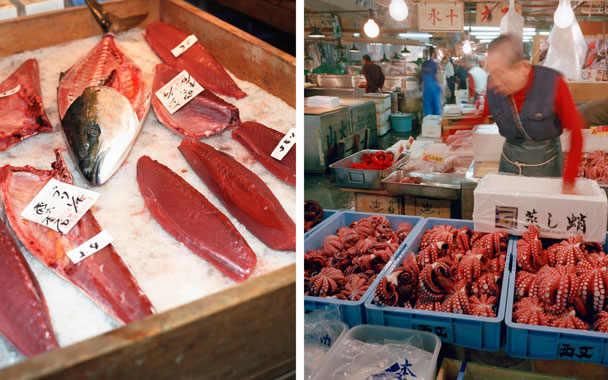Lying awake with jet lag in a Tokyo apartment at 5 A.M., I realized this was the perfect chance to visit Tsukiji, the world’s largest fish market, which was just a subway ride away. The early-morning auctions were already over, but the place would be bustling and the sushi houses nearby gearing up. Rousing my mother and her friend, we threw back our coffee and headed off into the pre-dawn night.
We were in Japan to visit cousins and aunts, a trip we make every decade or so, though I hadn’t been back since the late 1980s. I had visited Tsukiji then, but didn’t recall much except the chaotic hustle and the mountains of fish.
Walking the several blocks from the subway station to the market, past a sashimi-knife store and a noodle-soup vendor, was like was like entering an alternate universe of artisan shops against the more usual backdrop of convenience-store Tokyo.
Once into the narrow aisles of the market, we managed to make headway between the octopus and oysters, the salmon and snapper. These mid-level wholesalers had snapped up fish at the auctions earlier in the morning and now were reselling them to chefs or housewives eager for the freshest fish at the best prices.
We’d planned to browse and not to buy, but temptation proved too great and we decided to pick up the evening’s dinner. At a tuna stand, we bought some chu toro, a medium-fatty cut that I prefer to toro. I wanted to avoid over-fished bluefin, though it was impossible to tell what we were buying: My mother’s fluent Japanese faltered when it came to translating the name of the fish. I was later told that given the amount we spent— 4,000 yen (about $40) for two large fillets—it was unlikely we had bought bluefin, which would have been far pricier.
Nearby, fishmongers cut open tuna carcasses with giant six-foot knives, separating fillet from bone, while others ran frozen fish through circulating band saws. Buckets below collected the fish dust, presumably to be sold as scrap, alongside the piles of fish heads lying around on tables.
We moved from stall to stall, picking up my mother’s favorite tiny black clams, shijimi, and ikura (salmon roe, probably Alaskan); in the myriad stores outside Tsukiji, we bought fresh wasabi root, takuan (pickled white radish), cucumbers, and narazuke (melon pickled in sake brine) from large open vats. Nearby stores specialized in bonito—the dried fish that flavors the most basic Japanese stock, dashi—sold in hunks that looked like wedges of wood.
Back in the fish market, my mom bargained down the price for a small box of uni (sea urchin roe). When the deal was struck, we asked where we should eat sushi, since there were several restaurants within Tsukiji.
The uni man pulled out his cell phone, made a call, and said, “Let’s go, they have three seats!” He led us through the maze of the market at a fast clip—my mother and her friend struggling to keep up, dodging the carts and trucks—and finally ended up at Okame, a sushi house with maybe 10 seats. Once there, the uni man bid us farewell.
So at 8 A.M., the three of us sat down for omakase, chef’s choice. The chef had picked up all the fish at the market earlier that day and said he would stay open until he ran out of fish—”usually around 2 or 3 P.M.”
I had never eaten most of the fish laid out before us, aside from tai (sea bream), chu toro, saba (mackerel), anago (eel) and uni. Among my new discoveries: a crunchy fish the size of a needle; and mackerel skin curled around a stick and broiled crisp. We ate for nearly an hour, finally finishing up with miso shiro and green tea. It was among the best I’ve eaten—and certainly the best I’ve had at 8 A.M.
Our Version
Back home that day, my cousins got to work, soaking the rice and slicing the pickles and the tuna. I set about grating the wasabi root into a paste (“Don’t grate it too fast,” my aunt instructed, “or else it will oxidize. And don’t be angry while you do it, or it won’t taste good!”). She had bought some tofu from a vendor outside the subway station, which she heated in a broth and then drizzled with a bit of shoyu and a dash of the fresh wasabi.
When the rice was done, I fanned it as the sushi seasoning (rice-wine vinegar and sugar) was added. My cousin folded and then tore the sheets of nori (seaweed) for our hand rolls. Just then, a neighbor came and handed us a huge head of broccoli, picked from her community garden. My aunt had some soramame—“Aha,” I said, “fava beans!” —that we peeled open on the dining table. She boiled the pods in salt water.
When we sat down for the meal, we made hand rolls with the tender tuna slices; the soft ikura roe and earthy uni; the bright shiso leaf; the deeply flavored, gooey, fermented natto (an acquired taste, to be sure); the pickled takuan; and wasabi—all in various combinations nestled in rice and nori. The tofu, served on the side, was soft and comforting; we popped the fava beans into our mouths with no seasoning at all. You didn’t need much with all those flavors batting around.
As for my mother’s shijimi clams, they were cooked in miso soup until they opened. My aunt dished out a generous serving of clams into each bowl and then poured the miso broth on top. Tokyo clam chowder.
At the end, we were stuffed, the kids asleep on the couch. We sat around and drank sake until it was time to go, then went out into the cool Tokyo night.

